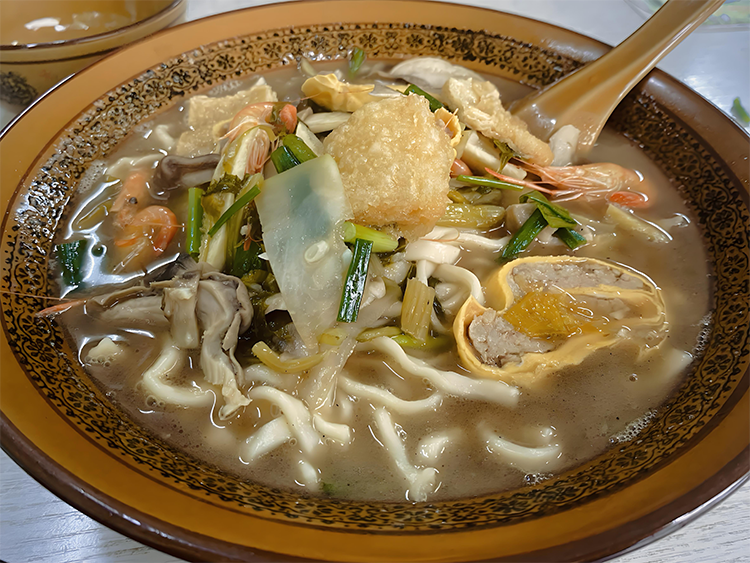Ciwu Hammered Noodles: Jiangnan’s Famous Taste
In the lanes of Zhuji, Zhejiang, a distinctive sound marks the start of many local days—the steady “tap-tap-tap” of a wooden mallet. That sound belongs to a time-honored noodle craft that produces one of Jiangnan’s celebrated dishes: Ciwu Hammered Noodles For travelers seeking authentic Zhejiang cuisine, tasting this bowl is essential. Follow the mallet’s beat and you’ll trace the noodle’s journey from dough to a steaming, savory bowl.
1. Origin in the Southern Song: History in Every Bite
Ciwu Hammered Noodles trace their roots back centuries, with stories linking their popularity to the late Yuan and early Ming eras. Local lore says that the founding emperor Zhu Yuanzhang once praised the noodles’ springy texture, giving the dish a reputation as an imperial favorite. Whether legend or fact, the tale underlines the deep local history. The technique has been passed down through generations in Ciwu town, and the repetitive, deliberate hammering of the dough preserves an authentic Jiangnan flavor that has endured through time.

2. Craft and Technique: The Power Behind the Dough
The essence of Ciwu Hammered Noodles is in the verb “hammered.” Unlike kneading, pulling, or cutting alone, hammered noodles rely on a rhythmic pounding that develops gluten differently. Skilled chefs select high-gluten flour, water, and a pinch of salt to form a large dough ball. Then, using a thick wooden mallet, they pound the dough for up to an hour in steady, practiced beats. This process lengthens protein chains and creates exceptional elasticity. After pounding, the dough is rolled thin, folded, and sliced into evenly thick noodles. The performance-like preparation—part strength, part finesse—gives the noodles their signature smoothness and chew.

3. The Heart of Flavor: Broth and Toppings in Harmony
A great bowl of Ciwu Hammered Noodles is a balance of noodle, broth, and toppings. The broth is often a milky, savory stock made by simmering pork bones and chicken carcasses for several hours, yielding richness without heaviness. Toppings—often called “toppings” or “toppings combos”—bring variety: fresh river shrimp add sweet ocean notes, tender pork kidney (waist flower) gives a silky texture, seasonal bamboo shoots provide a bright, vegetal fresh, and classic choices include pork chops, preserved mustard greens, or shredded pork. Chefs quickly stir-fry toppings to lock in flavor and pour them, along with their sizzling aroma, over the cooked noodles and steaming broth.

4. Taste Profile: Smooth, Springy, Unforgettable
When the bowl arrives, the first impression is aroma. Lift a few strands and you’ll notice the slightly ruffled edge created by the pounding. The first mouthful is startlingly smooth; the noodle slips easily, then reveals a pleasing chewiness—springy and resilient but never tough. The long-simmered broth clings to each strand, while toppings add contrasting textures and flavors. Salty, sweet, bright, and umami notes mingle, making the dish addictive. Ciwu Hammered Noodles deliver a layered eating experience that keeps locals—and curious travelers—coming back for more.

5. How to Eat Like a Local
There’s a subtle etiquette to enjoying these noodles. Don’t immediately stir. First sip the clear broth to taste its pure flavor. Then mix the noodles with toppings and broth so each strand is coated. Eat while hot to enjoy the ideal texture. Many shops serve free pickled radish or preserved vegetables as a palate cleanser—perfect for cutting richness. Locals also choose toppings by season: bamboo shoots in spring, tomato-and-egg in summer, river shrimp in autumn, and lamb in winter. Pairing your bowl with seasonal toppings is a way to dine like a Zhuji resident.

6. Visitor Tips: Finding the Most Authentic Bowl
For visitors in Zhejiang wanting the most authentic experience: head to small, longstanding noodle shops tucked in Zhuji’s old streets. Skip fancy decor; the best bowls come from places where locals queue. Listen for the mallet’s rhythm—that sound often signals genuine hammered noodles. Order a two- or three-topping bowl if you want variety; popular safe choices are kidney-and-shrimp or preserved-bamboo-and-shredded-pork. Peak hours are lunch (11:00–13:00) and dinner (17:00–19:00), so arrive slightly off-peak for a calmer experience.

7. Homemade Version: A Simple At-Home Recipe
While reproducing the exact mallet technique is difficult, you can make a home-style version: buy firm egg noodles or hand-rolled noodles as a substitute. Use a concentrated chicken or pork broth, add slices of ginger and scallion, and simmer briefly. For toppings, stir-fry shredded pork, mushrooms, or seasonal vegetables with garlic and soy. Cook the noodles, place them in a bowl, pour over hot broth, and top with stir-fried ingredients. It won’t replace the full Ciwu experience, but it will capture the comforting spirit.

8. Conclusion
In short, Ciwu Hammered Noodles are a perfect blend of force and finesse—sound, sight, and taste woven into a single bowl. They carry Zhuji’s history, showcase local craftsmanship, and warm both stomach and soul. When planning your next culinary trip through China’s Zhejiang province, reserve time for a bowl: listen for the mallet, savor the broth, and enjoy one of Jiangnan’s most memorable noodle traditions.


